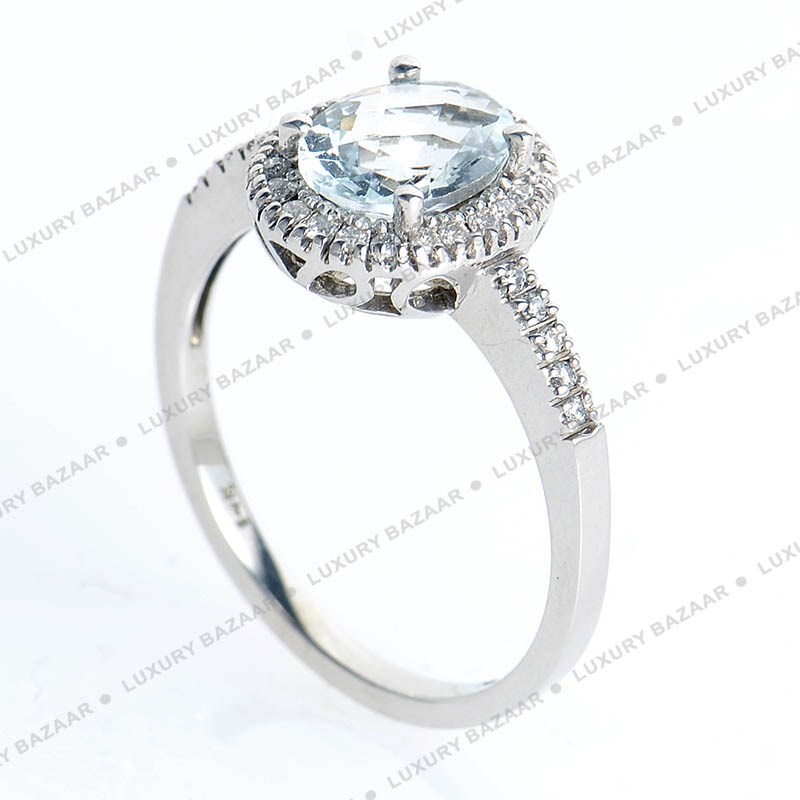

Aquamarine, however, can be cut in almost any way. Some gemstones are limited to a few types of cuts for bringing out their best sparkle and brilliance. Difference in CutĪn aquamarine’s cut maximizes its color and clarity as long as the cut is good. Many jewelry makers use tiny diamonds to complement the aquamarine centerpiece for engagement rings.

In engagement rings, high clarity aquamarine is usually used to give it great sparkle and brilliance. This results in a higher price for diamond jewelry with no visible inclusions.Īnother popular way that low clarity aquamarine is used in jewelry is as partially polished slice or a nugget in a necklace. People usually expect a diamond to have high clarity. In contrast, diamonds with visible inclusions are not commonly viewed as stylish or desirable. There is a trend in the jewelry industry to use included aquamarine as a centerpiece.


However, some consumers like how an aquamarine with inclusions looks in jewelry.
Aquamarine and diamond ring free#
Fortunately, most faceted aquamarine is free of visible inclusions, so you will have an easier time finding these valuable gems. Neither gemstone should have visible inclusions. Both aquamarine and diamond are durable enough for daily wear.Ī similarity between aquamarine vs diamond, clarity is one of the most important factors in the gem’s value. Although aquamarine isn’t as hard as diamond, it has decent hardness. Between aquamarine vs diamond, aquamarine scratches more easily as it has a lower hardness.ĭiamond has a hardness rating of 10, the highest among gemstones. Difference in HardnessĪquamarine has a hardness of 7.5-8 on the Mohs scale of hardness. Look for diamonds with very good or excellent cut if maximum sparkle is important to you. A poorly cut aquamarine loses significant sparkle, even if it has excellent clarity. Aquamarine that looks milky, cracked, or spotted has less sparkle than aquamarine that doesn’t. Because aquamarine is easy to cut, its sparkle is easy to enhance. It will come at a lower price since dark blue is in higher demand.īetween aquamarine vs diamond, diamond is well-known for its great sparkle. Aquamarine with a pastel blue color is just as good as dark blue. Although the industry has preferred colors, you can choose whichever shade of blue you like. Experts believe aquamarine’s color is most striking when the stone is five carats or larger. In aquamarine, the most valuable gems are dark blue to slightly greenish blue. K-M diamonds may have a yellow tint detectable by the naked eye. White diamonds can have a color rating from D to Z. Colored diamonds, those that aren’t clear or white, are graded on a separate color scale. Some people don’t want a diamond that has a slightly yellow tint, so they must pay attention to the color grading scale. Although color matters in a diamond too, it’s not as important as it is for aquamarine. Different from diamonds, aquamarine is sometimes large enough for 100 carat cuts.Īnother difference between aquamarine vs diamond is color is an important factor in buying aquamarine. Colored diamonds occur very rarely in nature, so they are more expensive than the clear kind. Diamonds are most commonly clear, but it’s possible to find blue diamonds. The gem is a variety of beryl, distinguished by this color. Difference in ColorĪquamarine ranges from blue to greenish blue in color. We have compared aquamarine vs diamond based on color, sparkle, hardness, clarity, cut, and price. If you’re trying to choose between the two as engagement ring stones, consider the important characteristics below. Aquamarine vs diamond has many other differences besides this. Some sellers create their own quality grading scale for aquamarine to help shoppers find the highest quality aquamarine. Aquamarine, however, doesn’t have a quality grading scale. Diamond has a standard quality grading scale for various important characteristics like color and clarity.


 0 kommentar(er)
0 kommentar(er)
